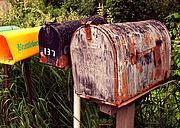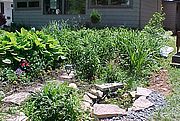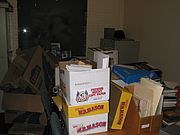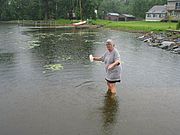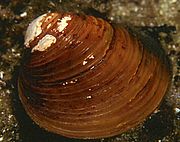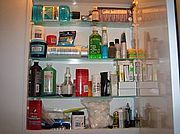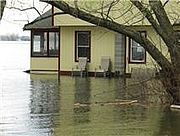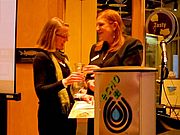
We’re delighted to note that LCC’s Blue Green Algae monitoring program received the Citizen Scientist Green Mountain Environmental Award. The awards were created by ECHO Lake Aquarium and Science Center and FreePressMedia to recognize environmental stewards and their initiatives that have shaped, inspired, encouraged and supported successful and long-term leadership of Vermont’s rich and diverse natural environment. LCC’s monitoring program provides weekly input to health managers during the summer recreation season about the location, density, and persistence of algae blooms and algae toxins. The information helps public health managers make informed decisions about when and where algae blooms may require beach closings. The volunteers develop a greater knowledge of the lake and become resources within their community for anyone with questions about algae blooms. Additionally, the data gathered by volunteers is adding to the understanding of what triggers algae blooms so we’re better able to prevent them in the future.
“You and the Lake Champlain Committee have been vital to the preservation of our great Lake. The citizen volunteer algae monitoring program is just one example of decades of environmental leadership by LCC,” noted US Senator Patrick Leahy in a congratulatory letter to LCC Executive Director Lori Fisher. “Thank you for your many contributions.” LCC extends our deep appreciation to ECHO and FreePressMedia for the award and $1,000 cash prize to support our work and to our dedicated blue green algae citizen monitors and partner agencies. Hats off to Dr. Mary Watzin and Susan Fuller of the Rubenstein School of Environment and Natural Resources at the University of Vermont, Linda Boccuzzo of the Vermont Department of Health, Angela Shambaugh of the Vermont Department of Environmental Conservation, and Bill Howland, Colleen Hickey, Eric Howe, Kathy Jarvis, and Meg Modley of the Lake Champlain Basin Program. There wouldn’t be a monitoring program without our dedicated group of “citizen scientists”. We applaud past and present volunteers Anne August, Jennifer Bowman, Jim and Sally Brabham, Catherine Brooks, Al Carpenter, Chris Case, Carson Cornbrooks, Ed and Joan Comolli, Deborah Diemand, Gerry Duprey, Marc Eisenhower, Ryan Garber, Lawrence Gillet, Dave Greenough, Sally Littlefield, Joan Louie, Bill Magnus, Bob Martell, Jon McBride, Gary Molinski, Jerry Morong, Bob Murphy, Nate Otis, Martha Perry, Keith Peterson, Larry and Jeannine Pratt, Mary Simmers, Mike Roach, Micah Rose, Stan Tuller, Mark Sweeney, Cheryl Ward, Doug Ward, and Albee Westover. Read...
If you’ve had an address change recently, please send us an email so we can update your files and ensure you receive news on lake issues and LCC’s work. Our primary form of communication with members is through email. By mailing electronically we save time and resources and reinforce the stewardship ethic of our mission. We don’t give away or sell email addresses. To ensure that our email messages get through to your inbox, please add lcc@ lakechamplaincommittee.org and the domain enews.lakechamplaincommittee.org to your safe/allowed list and address book. Thanks! Read...
Want to add to your properties’ curb appeal and protect Lake Champlain and other water ways? The Lake Champlain Committee encourages designing a water-smart yard that puts nature to work creating healthy lawns and gardens. Click on the title for resources and tips. Read...
We spent much of the last month moving the Lake Champlain Committee office. The move gave us an opportunity to weed through our files and cull much of the material that no longer seems relevant. It’s amazing how many papers accumulate over time. Homes and offices build up waste and periodic cleansings rid the space of excesses. So what about the lake? What happens to the excesses that fill-up Lake Champlain?
For over 10,000 years, sediments have been pouring into Lake Champlain. The pace of sedimentation has increased dramatically with development of the landscape, but it is not a new phenomenon. Much of what is now the Champlain Valley used to be part of Lake Champlain. Slowly, the lake fills in. Read...
Focus some of your spring cleaning efforts on shoreline areas this year. Lake flooding has washed up tons of debris around the lake. Extra hands will be needed to clear trash and prepare recreation areas for summer. Consider contacting the managers of a public lakeside recreation area near you and volunteering your services for when the waters recede. Read...
LCC is gearing up for the 2011 blue-green algae monitoring season. The LCC shoreline monitoring has been on-going since 2004. Our monitoring efforts concentrate on Missisquoi Bay and the northern lake where we know blooms are most common and most severe. We also have a limited number of sampling locations along the Main Lake and South Lake. If you are interested in conducting regular visual observations of water quality in your section of the lake contact LCC staff scientist Mike Winslow. Read...
Efforts are underway in Lake George to use benthic mats to exterminate a population of Asian clam. The Asian clam, Corbicula fluminea, is a small bivalve that is native to southern Asia, the eastern Mediterranean, and Australia. They are small, usually less than 1.5 inches in size, and have a light tan or brown shell (color varies) with distinctive concentric ridges. The Lake George population was discovered just last year, and is thought to be small enough that control efforts can lead to complete eradication. The benthic mats used for control are rolled out on the lake bottom and weighted down with steel rebar. The mats are expected to suffocate any Asian clams beneath them within 45-days. Read...
Near the end of the session a bill was introduced that proposed a number of programs and changes designed to improve water quality and the management of Lake Champlain. The specifics of the bill will clearly change as it moves forward. The bill was meant to begin a conversation about what legislative changes might be necessary. LCC has begun discussions with other groups about how to best shape this bill in the next year of the biennium. Read...
The Vermont House passed a bill that would strengthen participation of citizens in environmental enforcement decisions. The bill allows a 30-day public comment period on any penalties assessed with regard to environmental violations, and allows for anyone who does comment to challenge overly lenient penalties that might be assessed. The bill still needs to be considered in the Senate next year. Read...
The Vermont legislature passed a bill that will help facilitate drug take-back programs at pharmacies. Unwanted pharmaceuticals present a potential water quality hazard when they are carelessly dumped down the toilet. In an ideal situation consumers would be able to return unused pharmaceuticals to the pharmacy where they purchased them for proper disposal. However, such drug take-backs are complicated by a maze of federal and state regulations designed to keep the drugs off the black market. LCC ensured that voices of local law enforcement were heard when the bill was first considered in the House. The new Vermont law assures that consumers can lawfully deliver unused medications to properly authorized authorities for the purpose of disposal. Our thanks to Representative David Deen for sponsoring this bill and shepherding it through the Statehouse. Read...
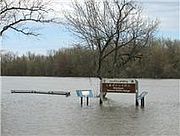
Lake flooding presents numerous recreational hazards. Incredible amounts of debris, large litter and logs, now float around the lake. Some normally exposed structures, like the Burlington breakwater, are under water. Many of Lake Champlain’s sand beaches are submerged and closed for the next several weeks. Damages can’t be fully assessed and clean up activities and repairs can’t begin until the waters recede. Additionally, water temperatures remain on the low end of average for this time of year, between 40 and 50º F. Submersion in waters that cold lead to exhaustion or unconsciousness in 30 to 60 minutes. Check in with the health department and local recreation department before taking to the water. Cold, turbid, debris-ridden water should be avoided. All boaters on the lake should exercise extreme caution. To further complicate matters, many of the lake access areas are underwater so launching a boat will present a problem. The National Weather Service office in Burlington discourages recreational boating at this time. Read...
Lake Champlain remains well above flood stage though it has receded from its maximum of 103.2’, reached on May 6th. At that height the lake contained an extra 867 billion gallons of water and the area of the lake increased by 15%. During the last week of April, the Winooski River carried half its usual annual load of phosphorus. On a single day, April 26th, the Winooski’s phosphorus discharge was two times the annual discharge of all Vermont wastewater plants combined. Stream gauges can not begin to estimate the amount of sediment and phosphorus deposited directly to the lake by shoreline erosion. We will continue to provide regular updates on the flooding impacts as the waters recede. Read...


